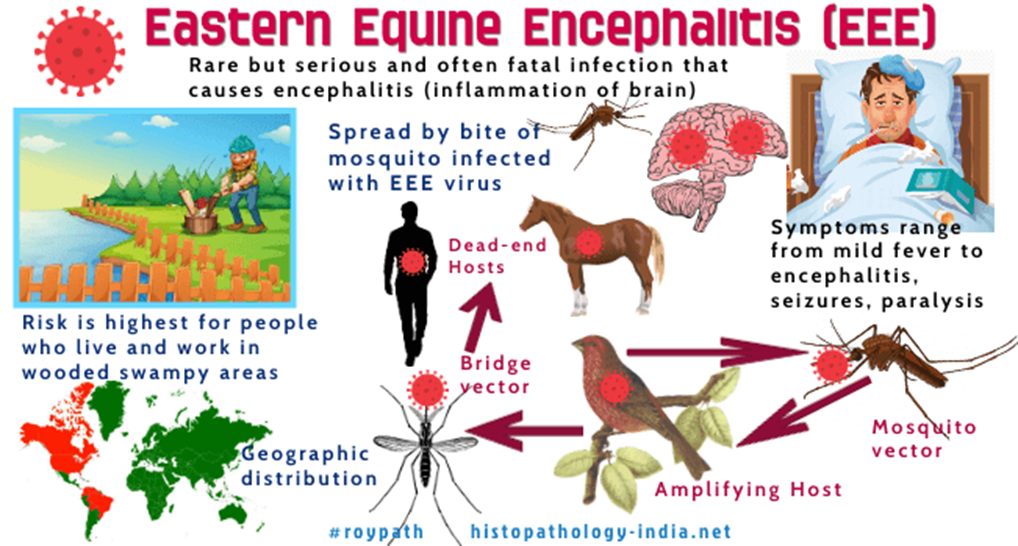
EASTERN EQUINE ENCEPHALITIS
Why in news?
Recently, Eastern equine encephalitis is rare in the US and only few cases are reported every year 30 per cent of which could turn fatal and may have severe symptoms.
About EEE
- Eastern equine encephalitis (EEE), commonly called Triple E or sleeping sickness (not to be confused with African trypanosomiasis), is a disease caused by a zoonotic mosquito vectored Togavirus that is present in North, Central, and South America, and the Caribbean.
- EEE was first recognized in Massachusetts, United States, in 1831, when 75 horses died mysteriously of viral encephalitis.
- Epizootics in horses have continued to occur regularly in the United States. It can also be identified in donkeys and zebras.
- Due to the rarity of the disease, its occurrence can cause economic impact beyond the cost of horses and poultry.
- EEE is found today in the eastern part of the United States and is often associated with coastal plains. It can most commonly be found in East Coast and Gulf Coast states.
- In Florida, about one to two human cases are reported a year, although over 60 cases of equine encephalitis are reported.
- In years in which conditions are favorable for the disease, the number of equine cases is over 200.
- Diagnosing equine encephalitis is challenging because many of the symptoms are shared with other illnesses and patients can be asymptomatic.
- Confirmations may require a sample of cerebral spinal fluid or brain tissue, although CT scans and MRI scans are used to detect encephalitis.
- This could be an indication that the need to test for EEE is necessary. If a biopsy of the cerebral spinal fluid is taken, it is sent to a specialized laboratory for testing.
- Eastern equine encephalitis virus (EEEV) is closely related to Venezuelan equine encephalitis virus and western equine encephalitis virus.
Symptoms of eastern equine encephalitis
- Starting from high fever, headache, chills and nausea, it can progress to seizures, disorientation, and coma.
- The survivors may face neurological issues. People in the age group of above 50 and under 15 are said to be more at risk.
- Not all people who contract the virus show symptoms and many people infected with eastern equine encephalitis (EEE) virus remain asymptomatic.
- The incubation period for those who display symptoms ranges from 4 to 10 days.
- It is the virus's impact on neurological health that's more concerning and can also leave an imprint even after recovery.
- As many as a third of people with the disease die and death usually occurs from 2 to 10 days after symptom onset.
- Even after recovery, people may face long-term physical or mental impairments ranging from mild brain dysfunction to severe intellectual impairment, personality disorders, seizures, paralysis, and cranial nerve dysfunction.
Treatment for eastern equine encephalitis
- There are no vaccines available to treat the disease. Precautionary measures are important.
- It has been advised to prevent mosquito bites and follow measures such as stopping mosquito breeding, applying repellents, and wearing full-sleeved shirt and full pants that cover the body.
- It is important to empty containers like flower pots, and uncovered water storage, as mosquitoes breed in such areas, to prevent mosquito breeding.


